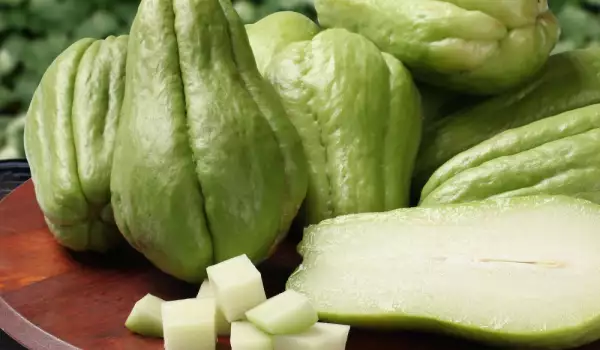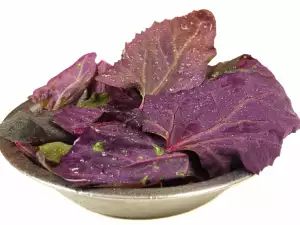Chayote (Sechium edule) is a tropical vine plant of the Cucurbitaceae family. It is also known by the names chuchu and pear squash. Chayote gained popularity primarily because of its pear-shaped fruits whose taste is reminiscent of pumpkin. It originates from Mexico but today is abundant in many areas of South America, Asia and Africa.
Chayote is a perennial plant and can grow for 7-8 years, as long as it is grown in a suitable tropical climate. The plant has a thick root. If cultivated, stems with thin offshoots sprout out. Its liana can reach 39.5 ft (12 m) in length. The leaves of chayote are green and pointed at the tips. They can reach 11 3/4″ (30 cm) in width and in length. Young leaves are covered with trichomes on both sides but once they age a little the ones found on one side fall off.
Chayote blooms from April to December, giving fruit from September to January. The fruits are meaty, reaching lengths from 1 1/2″ (4 cm) to 10 1/4″ (26 cm). Their width varies between 1 1/4″ (3 cm) and 4 1/4″ (11 cm). Even though the fruits are green, the saturation of the color can vary depending on the different cultivated forms. They can be covered with spines that are relatively soft and easy to remove. The meaty insides are whitish. In wild varieties, they taste a bit sour. This is something not seen in cultivated forms, where oftentimes there is a lack of any taste at all. Each fruit contains 1 large seed.

History of Chayote
The history of this exotic plant begins in Mexico. At first it was only found in the wild but slowly caught the attention of and was cultivated by the local Aztecs. Data do exist that the fruits were used by the Mayans. Gradually, chayote began gaining popularity and quickly spread in Guatemala, Salvador, Honduras, Costa Rica, Nicaragua and other countries. Ultimately, the inhabitants of the remaining continents came to know the curious fruit. Data obtained by Raphael Sadeh show that the plant Sechium edule was first described in 1756. The description came from Patrick Browne on the island of Jamaica.
Picking and Storing Chayote
If you've decided to try the exotic chayote, which is used as a vegetable in cuisine, you need to look for several things when choosing one. Touch the chayote to see whether or not it is soft.
The fresh fruits are firm and smooth. Check for any bruises on the surface because such fruits need to be avoided. Be careful not to purchase old ones. You will know them by their wrinkled and dry appearance. Otherwise, chayote can be stored for a long time. If you keep it in the refrigerator it will last several months.
Composition of Chayote
A whole bunch of beneficial substances are found in chayote's composition. It contains glycine, isoleucine, leucine, lysine, proline and others. In addition, there is phosphorus, zinc, manganese, copper, selenium, magnesium, iron. Chayote is a source of vitamin B6, vitamin C, vitamin E and vitamin K.

Cooking Chayote
Chayote is widely used in Mexican cuisine. The meaty part is used after the skin is removed. It can be added in raw form to salads or be heat treated. Fried, baked and boiled dishes use it. It can be stuffed. Appetizers and purees are also made from it. They can it in some areas. The majority of chayote products do not possess a strong characteristic taste, so it can be seasoned with all kinds of sauces and spices.
For those of you who like to experiment with exotic food products, here is a recipe for a chayote salad.
Ingredients: 10.5 oz chayote, 5 tbsp tomato paste, 3 carrots, 2 bunches green onions, 3 tbsp canned corn, 1 bunch of dill, 1 bunch of parsley, olive oil, 2 garlic cloves, vinegar, soya sauce, salt and black pepper - to taste.
Preparation:
Clean and wash the chayote and carrots, cut them coarsely. Braise them in oil and a little soya sauce for 3-4 min, then transfer them to a bowl. Put in the tomato paste and corn. Add the chopped onions, dill and parsley, as well as the crushed garlic. Season the salad with the remaining spices and mix it up.
Benefits of Chayote
Although chayote does not exactly shine with any particular taste qualities, it is very healthy. It has been proven that the consumption of this fruit is beneficial for our bodies due to the large amount of healthy substances. It is presumed that it has the ability to prevent the development of cardiovascular and bone diseases. Taking it leads to the stabilizing of blood pressure. According to the experts, chayote protects against certain cancers also. At the same time, eating this Mexican wonder food boosts the immune system and charges the body with energy, all while maintaining skin health and beauty.







